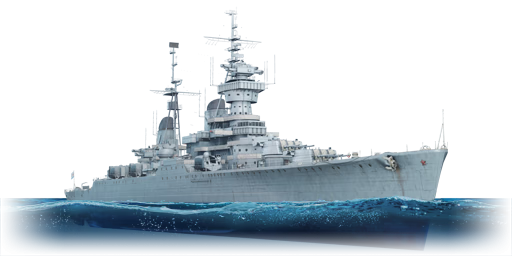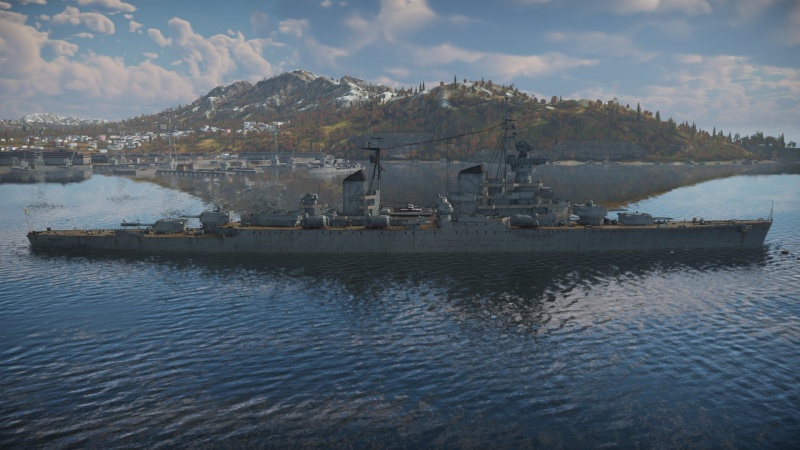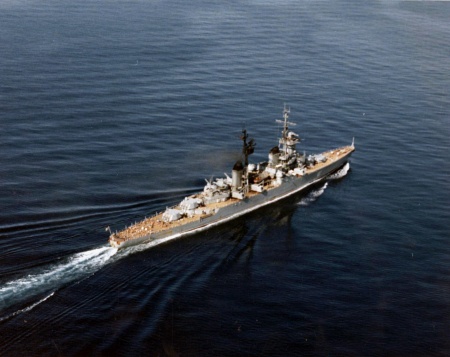Difference between revisions of "Sverdlov"
(Updated format) |
Bonisducks (talk | contribs) (→History) (Tag: Visual edit) |
||
| Line 65: | Line 65: | ||
== History == | == History == | ||
| − | + | <!-- Describe the history of the creation and combat usage of the ship in more detail than in the introduction. If the historical reference turns out to be too long, take it to a separate article, taking a link to the article about the ship and adding a block "/History" (example: https://wiki.warthunder.com/(Ship-name)/History) and add a link to it here using the main template. Be sure to reference text and sources by using <ref></ref>, as well as adding them at the end of the article with <references />. This section may also include the ship's dev blog entry (if applicable) and the in-game encyclopedia description (under === In-game description ===, also if applicable). -->[[File:Soviet cruiser Sverdlov in 1974.jpg|thumb|450x450px|The Soviet Cruiser Sverdlov underway in 1974.]] | |
| + | The Soviet cruiser Sverdlov was the lead ship of the Sverdlov class of light cruisers built for the Soviet navy in the 1950s. Being conventional cruisers, they were designed to function as bluewater ships with the ability to perform commerce raiding duties if required, similar to the German pocket battleships and battlecruisers. The ships inherited the hulls of the previous Chapayev class, but carried an improved armament and new sensor systems. Sverdlov was commissioned in 1952, and spent most of her operational career making visits to various foreign ports and countries. She was eventually retired in the late 1970s and scrapped shortly before the collapse of the Soviet Union. | ||
| + | === Design and development === | ||
| + | After the construction of the Chapayev class (Project 68), the Soviet Union began the development of an improved iteration of the ship, to be known as the Sverdlov class or Project 68bis. A total of 40 ships were intended to be built, along with the larger Stalingrad-class battlecruisers and Soviet aircraft carriers. As well, the ships were intended to be capable of commerce raiding, as shown by the conspicuous success of the German commerce raiders during World War II. As a result, the ships were the largest cruisers ever built by the Soviet navy up to that time (and largest until the introduction of the Kirov-class battlecruisers), displacing 16 640 tons. Because the Soviet Leader Stalin had been a supporter of the program, his death in 1953 saw the total number of ships cut to 14. The lead ship, Sverdlov, was laid down in October of 1949 and completed by May of 1952. | ||
| + | |||
| + | Sverdlov displaced 16 640 tons full and had a crew complement of 1250 officers and men. Her main armament consisted of twelve 6-inch (152 mm) guns in four triple turrets, similar to the British Crown Colony-class and American Cleveland-class. Despite this, the Sverdlovs were still inferior in armament to the American Baltimore-class and Des Moines-class cruisers that were then in service. The ships had a heavy anti-aircraft battery of twelve 100 mm guns in twin turrets, and 32 37 mm anti-aircraft guns in twin turrets. The ships also carried two quintuple torpedo tubes on their beam. Powered by steam turbines developing 118 000 shaft horsepower, the Sverdlov could make 32.5 knots (60 km/h) and had a range of 9000 nautical miles. | ||
| + | |||
| + | === Operational history === | ||
| + | The Sverdlov joined the Soviet 4th Fleet in 1952 after her commissioning, and soon after attended the coronation review of Queen Elizabeth II at Portsmouth. Soon after, she visited Portsmouth again as well as the Dutch port of Rotterdam. She received a major overhaul in 1960 before being laid up and decommissioned. In 1972, she was reactivated again, and visited several European ports before being retired one final time in 1978. By this time, the gun-cruiser nature of the Sverdlovs had made them highly obsolete. As a result, she was sold to an Indian ship-breaker company in 1991, and scrapped by 1993. Out of all the Sverdlov-class cruisers, only Mikhail Kutuzov survives to this day as a museum ship. | ||
== Media == | == Media == | ||
''Excellent additions to the article would be video guides, screenshots from the game, and photos.'' | ''Excellent additions to the article would be video guides, screenshots from the game, and photos.'' | ||
| Line 84: | Line 92: | ||
* [[wt:en/news/6610-development-sverdlov-class-the-tzar-of-the-seas-en|[Devblog] Sverdlov class: the Tzar of the Seas]] | * [[wt:en/news/6610-development-sverdlov-class-the-tzar-of-the-seas-en|[Devblog] Sverdlov class: the Tzar of the Seas]] | ||
| + | === References === | ||
| + | |||
| + | * Clarke, A. (2018, June 01). Sverdlov Class Cruisers, and the Royal Navy's Response. Retrieved January 20, 2021, from <nowiki>http://globalmaritimehistory.com/sverdlov_class_rn_response/</nowiki> | ||
{{USSR light cruisers}} | {{USSR light cruisers}} | ||
Revision as of 20:21, 20 January 2021
Contents
Description
The Pr.68-bis, Sverdlov, 1952 is a rank V Soviet light cruiser with a battle rating of 6.0 (AB/RB/SB). It was introduced in Update 1.97 "Viking Fury".
General info
Survivability and armour
Talk about the vehicle's armour. Note the most well-defended and most vulnerable zones, e.g. the ammo magazine. Evaluate the composition of components and assemblies responsible for movement and manoeuvrability. Evaluate the survivability of the primary and secondary armaments separately. Don't forget to mention the size of the crew, which plays an important role in fleet mechanics. Save tips on preserving survivability for the "Usage in battles" section. If necessary, use a graphical template to show the most well-protected or most vulnerable points in the armour.
Mobility
Write about the ship's mobility. Evaluate its power and manoeuvrability, rudder rerouting speed, stopping speed at full tilt, with its maximum forward and reverse speed.
Modifications and economy
Armament
Primary armament
Provide information about the characteristics of the primary armament. Evaluate their efficacy in battle based on their reload speed, ballistics and the capacity of their shells. Add a link to the main article about the weapon: {{main|Weapon name (calibre)}}. Broadly describe the ammunition available for the primary armament, and provide recommendations on how to use it and which ammunition to choose.
Secondary armament
Some ships are fitted with weapons of various calibres. Secondary armaments are defined as weapons chosen with the control Select secondary weapon. Evaluate the secondary armaments and give advice on how to use them. Describe the ammunition available for the secondary armament. Provide recommendations on how to use them and which ammunition to choose. Remember that any anti-air armament, even heavy calibre weapons, belong in the next section. If there is no secondary armament, remove this section.
Anti-aircraft armament
An important part of the ship's armament responsible for air defence. Anti-aircraft armament is defined by the weapon chosen with the control Select anti-aircraft weapons. Talk about the ship's anti-air cannons and machine guns, the number of guns and their positions, their effective range, and about their overall effectiveness – including against surface targets. If there are no anti-aircraft armaments, remove this section.
Additional armament
Describe the available additional armaments of the ship: depth charges, mines, torpedoes. Talk about their positions, available ammunition and launch features such as dead zones of torpedoes. If there is no additional armament, remove this section.
Usage in battles
Describe the technique of using this ship, the characteristics of her use in a team and tips on strategy. Abstain from writing an entire guide – don't try to provide a single point of view, but give the reader food for thought. Talk about the most dangerous opponents for this vehicle and provide recommendations on fighting them. If necessary, note the specifics of playing with this vehicle in various modes (AB, RB, SB).
Pros and cons
Pros:
- Very effective AA suite with 100 mm VT shells and 37 mm automatic guns
- Enough armour to withstand multiple shots
- 12 x 152 mm cannons with various types of ammunition
Cons:
- Difficult to manoeuvre
- After exhausting the first-stage storage of the main guns, the reload speed is significantly reduced
- If the torpedoes are loaded they can cause an explosion if they are hit, disabling or even sinking the ship
History
The Soviet cruiser Sverdlov was the lead ship of the Sverdlov class of light cruisers built for the Soviet navy in the 1950s. Being conventional cruisers, they were designed to function as bluewater ships with the ability to perform commerce raiding duties if required, similar to the German pocket battleships and battlecruisers. The ships inherited the hulls of the previous Chapayev class, but carried an improved armament and new sensor systems. Sverdlov was commissioned in 1952, and spent most of her operational career making visits to various foreign ports and countries. She was eventually retired in the late 1970s and scrapped shortly before the collapse of the Soviet Union.
Design and development
After the construction of the Chapayev class (Project 68), the Soviet Union began the development of an improved iteration of the ship, to be known as the Sverdlov class or Project 68bis. A total of 40 ships were intended to be built, along with the larger Stalingrad-class battlecruisers and Soviet aircraft carriers. As well, the ships were intended to be capable of commerce raiding, as shown by the conspicuous success of the German commerce raiders during World War II. As a result, the ships were the largest cruisers ever built by the Soviet navy up to that time (and largest until the introduction of the Kirov-class battlecruisers), displacing 16 640 tons. Because the Soviet Leader Stalin had been a supporter of the program, his death in 1953 saw the total number of ships cut to 14. The lead ship, Sverdlov, was laid down in October of 1949 and completed by May of 1952.
Sverdlov displaced 16 640 tons full and had a crew complement of 1250 officers and men. Her main armament consisted of twelve 6-inch (152 mm) guns in four triple turrets, similar to the British Crown Colony-class and American Cleveland-class. Despite this, the Sverdlovs were still inferior in armament to the American Baltimore-class and Des Moines-class cruisers that were then in service. The ships had a heavy anti-aircraft battery of twelve 100 mm guns in twin turrets, and 32 37 mm anti-aircraft guns in twin turrets. The ships also carried two quintuple torpedo tubes on their beam. Powered by steam turbines developing 118 000 shaft horsepower, the Sverdlov could make 32.5 knots (60 km/h) and had a range of 9000 nautical miles.
Operational history
The Sverdlov joined the Soviet 4th Fleet in 1952 after her commissioning, and soon after attended the coronation review of Queen Elizabeth II at Portsmouth. Soon after, she visited Portsmouth again as well as the Dutch port of Rotterdam. She received a major overhaul in 1960 before being laid up and decommissioned. In 1972, she was reactivated again, and visited several European ports before being retired one final time in 1978. By this time, the gun-cruiser nature of the Sverdlovs had made them highly obsolete. As a result, she was sold to an Indian ship-breaker company in 1991, and scrapped by 1993. Out of all the Sverdlov-class cruisers, only Mikhail Kutuzov survives to this day as a museum ship.
Media
Excellent additions to the article would be video guides, screenshots from the game, and photos.
See also
Links to articles on the War Thunder Wiki that you think will be useful for the reader, for example:
- reference to the series of the ship;
- links to approximate analogues of other nations and research trees.
External links
References
- Clarke, A. (2018, June 01). Sverdlov Class Cruisers, and the Royal Navy's Response. Retrieved January 20, 2021, from http://globalmaritimehistory.com/sverdlov_class_rn_response/
| USSR light cruisers | |
|---|---|
| Imperial Russia | |
| Svetlana-class | Krasny Krym* · Krasny Kavkaz* |
| * Laid down by Imperial Russian Navy; Finished and renamed by the USSR | |
| Project | Soviet Union |
| Pr.26 | Kirov · Voroshilov · Maxim Gorky |
| Pr.68 | Chapayev · Zheleznyakov |
| Pr.68-bis | Sverdlov · Mikhail Kutuzov |
| Pr.68-bis-ZiF | Shcherbakov |
| Lend-Lease | USA |
| Omaha-class | Murmansk |
| Trophies | Italy |
| Condottieri-class | Kerch |






